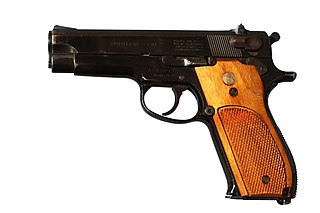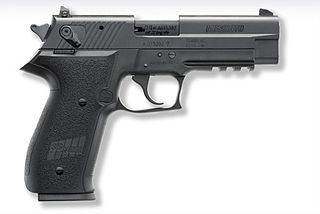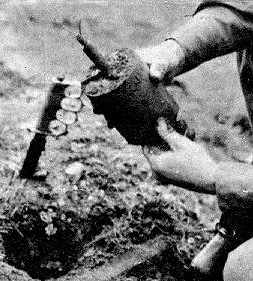
The Colt Python is a .357 Magnum caliber revolver formerly manufactured by Colt's Manufacturing Company of Hartford, Connecticut. It is sometimes referred to as a "Combat Magnum". It was first introduced in 1955, the same year as Smith & Wesson's M29 .44 Magnum. Now discontinued, the Colt Python was intended for the premium revolver market segment. Some firearm collectors and writers such as Jeff Cooper, Ian V. Hogg, Chuck Hawks, Leroy Thompson, Scott Wolber, Renee Smeets and Martin Dougherty have described the Python as the finest production revolver ever made.

The Dodge Power Wagon is a four wheel drive medium duty truck that was produced in various model series from 1945 to 1981 by Dodge, then as a nameplate for the Dodge Ram from 2005 to 2013, and, most recently ‘13-present, as an individual model marketed by Ram Trucks. It was developed as the WDX truck, and until about 1960 it was internally known by its engineering code T137 – a name still used for the original series by enthusiasts.

The Smith & Wesson Model 39 was a semi-automatic pistol developed for the US Army service pistol trials of 1954. After the Army abandoned its search for a new pistol, the Model 39 went on the civilian market in 1955 and was the first of Smith & Wesson's first generation semi-automatic pistols. A modified version saw limited use with Naval Special Warfare units as the Mk 22 Mod 0.

The Type 93 mine was a circular Japanese landmine used during the Second World War. It entered service in 1933. It used a simple fuze with a variable activation pressure, achieved through the use of different thickness shear wires. The main charge could be supplemented with additional explosives buried under the mine.
The Type 96 mine is a Japanese large hemispherical landmine used during the Second World War. It entered service in 1936. The mine could be deployed in shallow water or on land, and used two lead alloy horn fuzes. The horns contained a glass vial filled with an electrolytic fluid, that when released triggered the electrical fuze detonating the mine.

The TM-38 was a rectangular, metal-cased Soviet anti-tank mine used during the Second World War. The mine had a large raised rectangular central pressure plate with four reinforcing creases. When enough pressure was applied to the plate it collapses pressing down on a bolt connected to an internal lever. The lever is pulls a retaining pin from the MUV fuze, which releases the striker, which impacts the MD-2 detonator.

The Stokes mortar was a British trench mortar designed by Sir Wilfred Stokes KBE that was issued to the British and U.S. armies, as well as the Portuguese Expeditionary Corps, during the later half of the First World War. The 3-inch trench mortar is a smooth-bore, muzzle-loading weapon for high angles of fire. Although it is called a 3-inch mortar, its bore is actually 3.2 inches or 81 mm.

The Mle 1939 was a French bouncing anti-personnel mine used at the start of the Second World War, it was developed largely in response to the German S-mine bounding mine. It saw very little service before the fall of France. The plans escaped to the US via Major Pierre Delalande, a member of the French Corps of Engineers, and were used as the basis for the American M2 bounding mine which saw wider service during the war but was considered largely ineffective. The M2 mine was replaced almost immediately afterwards with the M16 bounding mine, an almost exact copy of the German S-mine. The French also later produced a copy of the S-mine, the Mle 1951 mine.
The Mle 1951 or MI AP ID 51 is a small circular French brown plastic cased minimum metal mine anti-personnel blast mine. The mine uses a pressure fuze that works by driving a firing pin through a friction sensitive compound. The mines safety is a small cap that sits over the pressure fuze and prevents it being pressed. The mine can be used with anti-handling devices.

A handgun is a short-barrelled firearm that can be held and used with one hand. The two most common handgun sub-types in use today are revolvers and semi-automatic pistols.

The M1935 is a French heavy anti-tank mine. It consists of a large heavy steel base plate with a hinged thin steel lid. Inside the lid it has a rectangular steel container, which holds the explosive charge. The mines are laid at a minimum interval of six feet.

The SIG Sauer Mosquito is a blowback-operated, semi-automatic pistol based on the SIG Sauer P226, but 10% smaller in size and chambered for the .22 LR cartridge. The pistol is manufactured with an aluminum-zinc alloy slide and polymer frame. The controls are similar to those present on full-size models and include a left takedown lever, a left decocking lever, reversible magazine catch and ambidextrous manual safety. In addition, the pistol is provided with an integral safety lock located at the rear of the magazine well which when enabled prevents cycling of slide, hammer fall, and trigger action. The pistol is available in five different configurations: Standard model, Sport, Threaded barrel, Two-tone, Reversed two-tone, and four special editions having different colors.
The Mossberg 185 is a 20-gauge bolt action shotgun, produced between 1948 and 1964 by O.F. Mossberg & Sons in New Haven, Conn.

Mogador was the lead ship of the French Navy's Mogador class of destroyers. Named for the Moroccan town, she was built before the outbreak of World War II. The ship was heavily damaged during the British attack on Mers-el-Kébir on 3 July 1940, but was later repaired and sailed to Toulon. She was scuttled in Toulon Harbor when the Germans tried to seize her, along with the rest of the fleet, on 27 November 1942.

The Remington Adaptive Combat Rifle is a modular semi-automatic rifle designed by Magpul Industries of Austin, Texas, and known initially as the Masada.

The Vepr-12 is a multipurpose semi-automatic detachable-magazine shotgun, produced by Molot-Oruzhie Ltd. It is patterned after the original Kalashnikov rifle and built on the heavier RPK light machine gun receiver.

The Vityaz-SN is a 9×19mm Parabellum submachine gun developed in 2004 by Izhmash. It is based on the AK-74 and offers a high degree of parts commonality with the AK-74. The gun is directly developed from the PP-19 Bizon. It is the standard submachine gun for all branches of the Russian military and police forces. "Vityaz" (витязь) is Russian for "knight".

The SIG Sauer P227 is a United States designed and produced semi-automatic handgun which was first introduced in 2013. The SIG Sauer P227 introduced a double-stack .45 ACP caliber handgun into the SIG Sauer lineup. It was introduced along with the P224.
The Stevens Model 520 was a pump-action shotgun developed by John Browning and originally manufactured by the J Stevens Arms & Tool Company between 1909 and 1916. Stevens was sold to New England Westinghouse on 28 May 1915 and production of civilian firearms was greatly reduced. The company was renamed the "J Stevens Arms Company" on 1 July 1916 and New England Westinghouse used their manufacturing facility in Chicopee Falls, MA to produce Mosin-Nagant rifles under contract for the Russian Czar during World War I. After the war, Stevens was sold to Savage Arms on 1 April 1920 and full production of civilian firearms resumed. Under Savage ownership, Model 520 production continued until 1939 when it was replaced by the Model 520A which ended production in 1948. Stevens also further modified the design when they introduced the streamlined Model 620 in 1927. The Model 620 was internally similar to the Model 520 and was produced until 1939 when it was replaced by the Model 620A which ended production in 1955. This shotgun is a hammerless, pump action, take-down design with a tubular magazine which holds 5 shells. All models can also be slam fired: the shotgun has no trigger disconnector and shells can be fired one after the other simply by working the slide if the trigger is held down.

















